昨天介紹了WGAN的原理,雖然在昨天看到各種公式可能會被嚇到,其中其實也還有許多細節可以介紹。雖然數學公式繁雜,不過建立WGAN模型卻很簡單。接下來就來一步一步建立WGAN吧!
WGAN模型與普通GAN在實作上只有一些差異,分別為:
Wasserstein Loss。這裡也一樣,使用WGAN做mnist手寫資料集的圖片生成。此外這次的WGAN模型是從DCGAN改來的,而非原始的GAN。
這邊與DCGAN不同的是優化器的使用從Adam變成RMSprop、以及要計算Wasserstein Loss我們需要使用Keras的後端API去計算。
要使用Keras後端必須匯入import tensorflow.keras.backend as K,至於為甚麼叫 ”K” 這我想應該是不成文的規定吧XD,畢竟Github上大家使用都是默認為K。
from tensorflow.keras.datasets import mnist
from tensorflow.keras.layers import Input, Dense, Reshape, Flatten, BatchNormalization, LeakyReLU, Activation, Conv2DTranspose, Conv2D
from tensorflow.keras.models import Model, save_model
from tensorflow.keras.optimizers import RMSprop #RMSprop優化器
import tensorflow.keras.backend as K #Keras後端
import matplotlib.pyplot as plt
import numpy as np
import os
這部分也沒有改變。讓圖片的像素值落在-1~1之間,以符合生成器輸出層的 tanh 激活函數輸出。
def load_data(self):
(x_train, _), (_, _) = mnist.load_data() # 底線是未被用到的資料,可忽略
x_train = (x_train / 127.5)-1 # 正規化
x_train = x_train.reshape((-1, 28, 28, 1))
return x_train
這裡與DCGAN不同的是要新增權重裁剪的上下限(self.clip_value = clip_value),定義在初始化__init__()方法中。
class WGAN():
def __init__(self, generator_lr, discriminator_lr, clip_value):
self.generator_lr = generator_lr
self.discriminator_lr = discriminator_lr
self.discriminator = self.build_discriminator()
self.generator = self.build_generator()
self.adversarial = self.build_adversarialmodel()
self.clip_value = clip_value #權重裁剪的上下限
self.gloss = []
self.dloss = []
if not os.path.exists('./result/WGAN/imgs'):# 將訓練過程產生的圖片儲存起來
os.makedirs('./result/WGAN/imgs')# 如果忘記新增資料夾可以用這個方式建立
接著來定義生成器、判別器與對抗模型吧!
生成器:
生成器與DCGAN沒啥差別。
def build_generator(self):
input_ = Input(shape=(100, ))
x = Dense(7*7*32)(input_)
x = BatchNormalization(momentum=0.8)(x)
x = Activation('relu')(x)
x = Reshape((7, 7, 32))(x)
x = Conv2DTranspose(128, kernel_size=4, strides=2, padding='same')(x)
x = BatchNormalization(momentum=0.8)(x)
x = Activation('relu')(x)
x = Conv2DTranspose(256, kernel_size=4, strides=2, padding='same')(x)
x = BatchNormalization(momentum=0.8)(x)
x = Activation('relu')(x)
out = Conv2DTranspose(1, kernel_size=4, strides=1, padding='same', activation='tanh')(x)
model = Model(inputs=input_, outputs=out, name='Generator')
model.summary()
return model
判別器:
判別器要注意輸出層不設定激活函數。
def build_discriminator(self):
input_ = Input(shape = (28, 28, 1))
x = Conv2D(256, kernel_size=4, strides=2, padding='same')(input_)
x = LeakyReLU(alpha=0.2)(x)
x = Conv2D(128, kernel_size=4, strides=2, padding='same')(x)
x = LeakyReLU(alpha=0.2)(x)
x = Conv2D(64, kernel_size=4, strides=1, padding='same')(x)
x = LeakyReLU(alpha=0.2)(x)
x = Flatten()(x)
out = Dense(1)(x) #不設定激活函數
model = Model(inputs=input_, outputs=out, name='Discriminator')
dis_optimizer = RMSprop(learning_rate=self.discriminator_lr)
model.compile(loss=self.wasserstein_loss,
optimizer=dis_optimizer,
metrics=['accuracy'])
model.summary()
return model
Wasserstein Loss:
昨天介紹了一堆公式,但使用了Keras後端來實現Wasserstein Loss其實意外的簡單。K.mean()是計算張量的平均值。
def wasserstein_loss(self, y_true, y_pred): #這個方法的參數是固定的必須要有y_true, y_pred
return K.mean(y_true * y_pred)
就這樣,沒了XD
不過為甚麼昨天講了一堆公式而今天實作卻變成這樣?原因是因為昨天提到WGAN的判別器會判斷圖片是真實圖片的程度。以往會使用Sigmoid來判斷圖片是真是假的機率,但在WGAN中判別器並沒有輸出函數,也就是線性的輸出,那判別器希望在面對真實圖片與生成圖片的距離盡可能大。要實現這點最好的方式根據以前的實驗就是將生成圖片的label標記為1而真實圖片標記為-1,這些label的輸出將立即帶來損失。圖片的標記方式待會訓練步驟中會定義,這個比較重要需要注意一下!
不過label設定真實圖片為1而生成圖片為-1好像也可以~
對抗模型:
對抗模型也沒有甚麼變動,只有使用RMSprop作為優化器與損失使用自定義的Wasserstein Loss而已。
def build_adversarialmodel(self):
noise_input = Input(shape=(100, ))
generator_sample = self.generator(noise_input)
self.discriminator.trainable = False
out = self.discriminator(generator_sample)
model = Model(inputs=noise_input, outputs=out)
adv_optimizer = RMSprop(learning_rate=self.generator_lr)
model.compile(loss=self.wasserstein_loss, optimizer=adv_optimizer)
model.summary()
return model
訓練步驟:
⚠️這邊要注意一下判別器的權重裁剪的部分喔!以及訓練標籤的設定。
權重裁減的部分流程上來說會
for l in self.discriminator.layers:來讀取每一層的資料。l.get_weights()來取得該層的權重。np.clip(w, -self.clip_value, self.clip_value)代表權重 w 如果小於-self.clip_value則 w=-self.clip_value;反之如果權重 w 大於self.clip_value則 w=self.clip_value。另外[元素 for 變數 in 可迭代物件]是Python中生成式的寫法,若不清楚各位可以參考我一年前寫的青澀文章,裡面就有介紹到。l.set_weights(weights)。def train(self, epochs, batch_size=128, sample_interval=50):
# 準備訓練資料
x_train = self.load_data()
# 準備訓練的標籤,分為真實標籤與假標籤,需注意標籤的內容!
valid = -np.ones((batch_size, 1))
fake = np.ones((batch_size, 1))
for epoch in range(epochs):
# 隨機取一批次的資料用來訓練
idx = np.random.randint(0, x_train.shape[0], batch_size)
imgs = x_train[idx]
# 從常態分佈中採樣一段雜訊
noise = np.random.normal(0, 1, (batch_size, 100))
# 生成一批假圖片
gen_imgs = self.generator.predict(noise)
# 判別器訓練判斷真假圖片
d_loss_real = self.discriminator.train_on_batch(imgs, valid)
d_loss_fake = self.discriminator.train_on_batch(gen_imgs, fake)
d_loss = 0.5 * np.add(d_loss_real, d_loss_fake)
# 權重裁剪
for l in self.discriminator.layers:
weights = l.get_weights()
weights = [np.clip(w, -self.clip_value, self.clip_value) for w in weights]
l.set_weights(weights)
#儲存鑑別器損失變化 索引值0為損失 索引值1為準確率
self.dloss.append(d_loss[0])
# 訓練生成器的生成能力
noise = np.random.normal(0, 1, (batch_size, 100))
g_loss = self.adversarial.train_on_batch(noise, valid)
# 儲存生成器損失變化
self.gloss.append(g_loss)
# 將這一步的訓練資訊print出來
print(f"Epoch:{epoch} [D loss: {d_loss[0]}, acc: {100 * d_loss[1]:.2f}] [G loss: {g_loss}]")
# 在指定的訓練次數中,隨機生成圖片,將訓練過程的圖片儲存起來
if epoch % sample_interval == 0:
self.sample(epoch)
self.save_data()
這邊也沒有變化,唯一需要改變儲存路徑而已:
def save_data(self):
np.save(file='./result/WGAN/generator_loss.npy',arr=np.array(self.gloss))
np.save(file='./result/WGAN/discriminator_loss.npy', arr=np.array(self.dloss))
save_model(model=self.generator,filepath='./result/WGAN/Generator.h5')
save_model(model=self.discriminator,filepath='./result/WGAN/Discriminator.h5')
save_model(model=self.adversarial,filepath='./result/WGAN/Adversarial.h5')
以及生成圖片的部分依然不變:
def sample(self, epoch=None, num_images=25, save=True):
r = int(np.sqrt(num_images))
noise = np.random.normal(0, 1, (num_images, 100))
gen_imgs = self.generator.predict(noise)
gen_imgs = (gen_imgs+1)/2
fig, axs = plt.subplots(r, r)
count = 0
for i in range(r):
for j in range(r):
axs[i, j].imshow(gen_imgs[count, :, :, 0], cmap='gray')
axs[i, j].axis('off')
count += 1
if save:
fig.savefig(f"./result/WGAN/imgs/{epoch}epochs.png")
else:
plt.show()
plt.clos
接著開始訓練吧,根據一些文獻與實驗,我們將學習率設定0.00005然後裁剪值設定0.01,如下表。
| 參數 | 參數值 |
|---|---|
| 生成器學習率 | 0.00005 |
| 判別器學習率 | 0.00005 |
| Batch Size | 128 |
| 訓練次數 | 10000 |
| 裁剪值(clip value) | 0.01 |
超參數設定各位可以依照自己喜歡調整,並看看實驗結果如何。
if __name__ == '__main__':
gan = WGAN(generator_lr=0.00005, discriminator_lr=0.00005, clip_value=0.01)
gan.train(epochs=10000, batch_size=128, sample_interval=200)
gan.sample(save=False)
損失圖如下,使用WGAN可以比較好的看到生成器的進步狀況,基本上約4000~5000左右生成器就沒什麼進步了: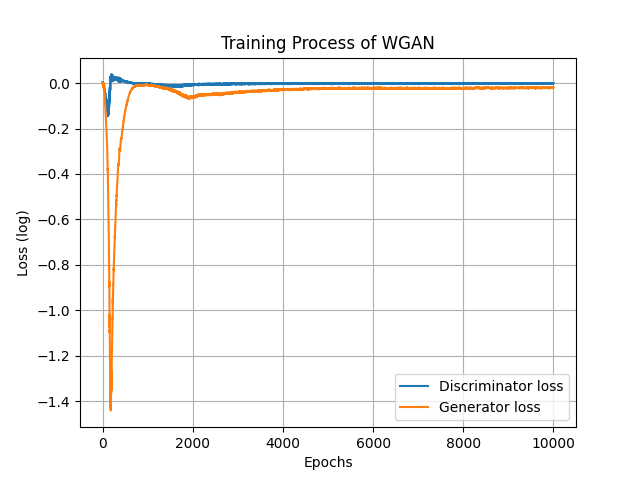
訓練過程跟以往差不多,但很明顯的比較穩定,不像DCGAN花了”億”點點時間調整參數與模型架構,為的就是不要讓訓練失衡。
Epoch=200。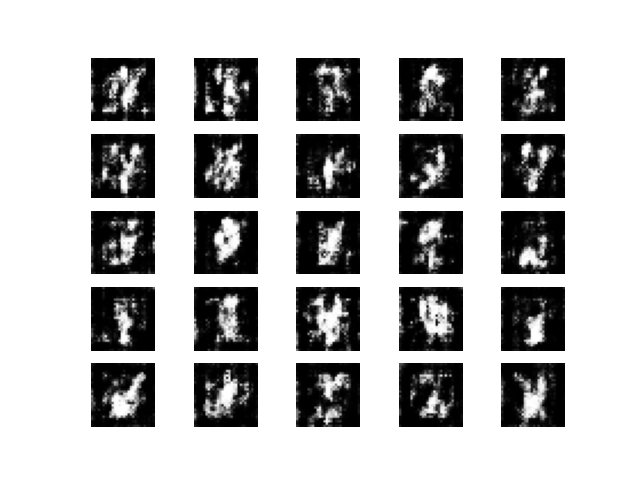
Epoch=2000。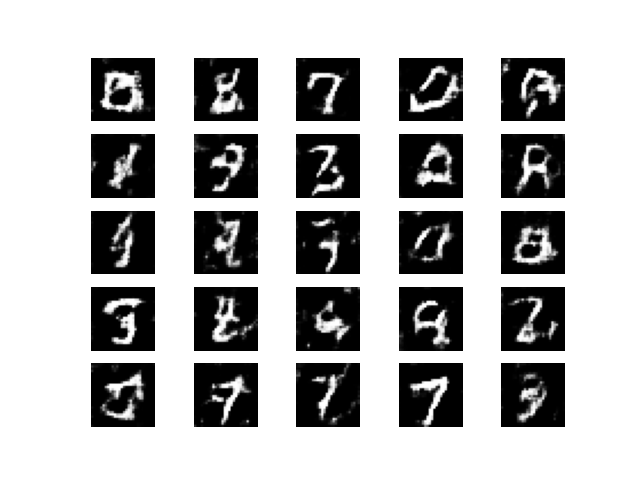
Epoch=5000。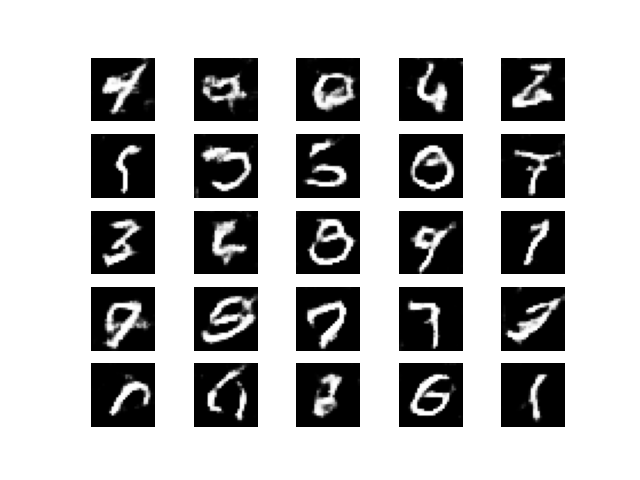
Epoch=10000。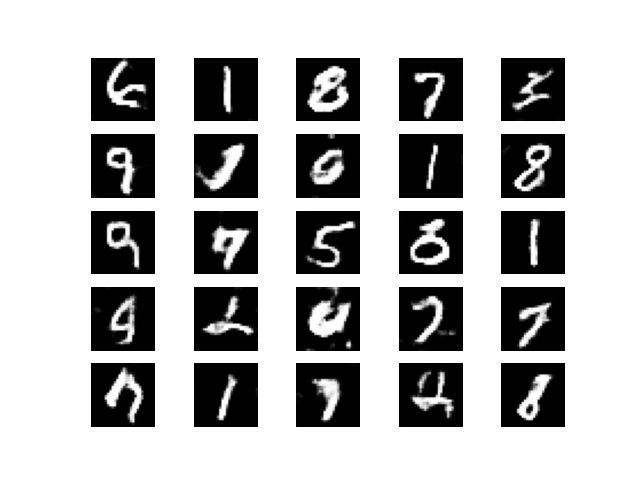
總得來說訓練結果有可能會沒有比DCGAN好,但是WGAN就勝在他訓練穩定且訓練曲線是有意義的。有很多時候不同的GAN訓練不穩定時就會考慮使用WGAN及其變種的方法來改寫網路的目標函數等,所以WGAN對於GAN的發展還是有重大意義的。
最後訓練過程產生的動圖如下:
今天帶各位實作了WGAN,雖然數學原理不簡單,但寫成程式後卻意外的簡單呢。不過WGAN在權重裁剪時太暴力了,所以權重有時會處於極端值。對此WGAN-GP解決了這個問題。WGAN-GP主要工作是加入了梯度懲罰,如果梯度的範數偏離其目標範數值,也就是偏離 1 時,WGAN-GP 就會對直接模型進行懲罰,而不是使用梯度裁剪暴力地將梯度值裁剪成上下限值。不過使用這個梯度懲罰的方式會增加計算負擔,使訓練時間變更長,但好處是訓練會比WGAN更穩定。WGAN-GP的具體內容、詳細資訊等各位如果有興趣可以再看看上方超連結喔。
from tensorflow.keras.datasets import mnist
from tensorflow.keras.layers import Input, Dense, Reshape, Flatten, BatchNormalization, LeakyReLU, Activation, Conv2DTranspose, Conv2D
from tensorflow.keras.models import Model, save_model
from tensorflow.keras.optimizers import RMSprop #RMEprop優化器
import tensorflow.keras.backend as K #Keras後端
import matplotlib.pyplot as plt
import numpy as np
import os
class WGAN():
def __init__(self, generator_lr, discriminator_lr, clip_value):
self.generator_lr = generator_lr
self.discriminator_lr = discriminator_lr
self.discriminator = self.build_discriminator()
self.generator = self.build_generator()
self.adversarial = self.build_adversarialmodel()
self.clip_value = clip_value
self.gloss = []
self.dloss = []
if not os.path.exists('./result/WGAN/imgs'):# 將訓練過程產生的圖片儲存起來
os.makedirs('./result/WGAN/imgs')# 如果忘記新增資料夾可以用這個方式建立
def load_data(self):
(x_train, _), (_, _) = mnist.load_data() # 底線是未被用到的資料,可忽略
x_train = (x_train / 127.5)-1 # 正規化
x_train = x_train.reshape((-1, 28, 28, 1))
return x_train
def wasserstein_loss(self, y_true, y_pred):
return K.mean(y_true * y_pred)
def build_generator(self):
input_ = Input(shape=(100, ))
x = Dense(7*7*32)(input_)
x = BatchNormalization(momentum=0.8)(x)
x = Activation('relu')(x)
x = Reshape((7, 7, 32))(x)
x = Conv2DTranspose(128, kernel_size=4, strides=2, padding='same')(x)
x = BatchNormalization(momentum=0.8)(x)
x = Activation('relu')(x)
x = Conv2DTranspose(256, kernel_size=4, strides=2, padding='same')(x)
x = BatchNormalization(momentum=0.8)(x)
x = Activation('relu')(x)
out = Conv2DTranspose(1, kernel_size=4, strides=1, padding='same', activation='tanh')(x)
model = Model(inputs=input_, outputs=out, name='Generator')
model.summary()
return model
def build_discriminator(self):
input_ = Input(shape = (28, 28, 1))
x = Conv2D(256, kernel_size=4, strides=2, padding='same')(input_)
x = LeakyReLU(alpha=0.2)(x)
x = Conv2D(128, kernel_size=4, strides=2, padding='same')(x)
x = LeakyReLU(alpha=0.2)(x)
x = Conv2D(64, kernel_size=4, strides=1, padding='same')(x)
x = LeakyReLU(alpha=0.2)(x)
x = Flatten()(x)
out = Dense(1)(x)
model = Model(inputs=input_, outputs=out, name='Discriminator')
dis_optimizer = RMSprop(learning_rate=self.discriminator_lr)
model.compile(loss=self.wasserstein_loss,
optimizer=dis_optimizer,
metrics=['accuracy'])
model.summary()
return model
def build_adversarialmodel(self):
noise_input = Input(shape=(100, ))
generator_sample = self.generator(noise_input)
self.discriminator.trainable = False
out = self.discriminator(generator_sample)
model = Model(inputs=noise_input, outputs=out)
adv_optimizer = RMSprop(learning_rate=self.generator_lr)
model.compile(loss=self.wasserstein_loss, optimizer=adv_optimizer)
model.summary()
return model
def train(self, epochs, batch_size=128, sample_interval=50):
# 準備訓練資料
x_train = self.load_data()
# 準備訓練的標籤,分為真實標籤與假標籤,需注意標籤的內容!
valid = -np.ones((batch_size, 1))
fake = np.ones((batch_size, 1))
for epoch in range(epochs):
# 隨機取一批次的資料用來訓練
idx = np.random.randint(0, x_train.shape[0], batch_size)
imgs = x_train[idx]
# 從常態分佈中採樣一段雜訊
noise = np.random.normal(0, 1, (batch_size, 100))
# 生成一批假圖片
gen_imgs = self.generator.predict(noise)
# 判別器訓練判斷真假圖片
d_loss_real = self.discriminator.train_on_batch(imgs, valid)
d_loss_fake = self.discriminator.train_on_batch(gen_imgs, fake)
d_loss = 0.5 * np.add(d_loss_real, d_loss_fake)
# 權重裁剪
for l in self.discriminator.layers:
weights = l.get_weights()
weights = [np.clip(w, -self.clip_value, self.clip_value) for w in weights]
l.set_weights(weights)
#儲存鑑別器損失變化 索引值0為損失 索引值1為準確率
self.dloss.append(d_loss[0])
# 訓練生成器的生成能力
noise = np.random.normal(0, 1, (batch_size, 100))
g_loss = self.adversarial.train_on_batch(noise, valid)
# 儲存生成器損失變化
self.gloss.append(g_loss)
# 將這一步的訓練資訊print出來
print(f"Epoch:{epoch} [D loss: {d_loss[0]}, acc: {100 * d_loss[1]:.2f}] [G loss: {g_loss}]")
# 在指定的訓練次數中,隨機生成圖片,將訓練過程的圖片儲存起來
if epoch % sample_interval == 0:
self.sample(epoch)
self.save_data()
def save_data(self):
np.save(file='./result/WGAN/generator_loss.npy',arr=np.array(self.gloss))
np.save(file='./result/WGAN/discriminator_loss.npy', arr=np.array(self.dloss))
save_model(model=self.generator,filepath='./result/WGAN/Generator.h5')
save_model(model=self.discriminator,filepath='./result/WGAN/Discriminator.h5')
save_model(model=self.adversarial,filepath='./result/WGAN/Adversarial.h5')
def sample(self, epoch=None, num_images=25, save=True):
r = int(np.sqrt(num_images))
noise = np.random.normal(0, 1, (num_images, 100))
gen_imgs = self.generator.predict(noise)
gen_imgs = (gen_imgs+1)/2
fig, axs = plt.subplots(r, r)
count = 0
for i in range(r):
for j in range(r):
axs[i, j].imshow(gen_imgs[count, :, :, 0], cmap='gray')
axs[i, j].axis('off')
count += 1
if save:
fig.savefig(f"./result/WGAN/imgs/{epoch}epochs.png")
else:
plt.show()
plt.close()
if __name__ == '__main__':
gan = WGAN(generator_lr=0.00005,discriminator_lr=0.00005, clip_value=0.01)
gan.train(epochs=10000, batch_size=128, sample_interval=200)
gan.sample(save=False)
